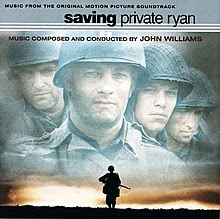Music Album Review: 'Saving Private Ryan: Music from the Original Motion Picture Soundtrack'

(C) 1998 Dreamworks Records. Movie poster art (C) 1998 Dreamworks SKG John Williams' score for Saving Private Ryan, Steven Spielberg's searing World War II drama about eight U.S. soldiers ordered to rescue a paratrooper whose three brothers lost their lives in combat, follows the simple-is-better-than-operatic format that made his music for 1993's Schindler's List powerful and effective. Considering that most of Williams' film scores tend to be very bombastic and energetic (his Star Wars and Indiana Jones music tends to follow the Wagner/Korngold tradition of big orchestras and action-oriented cues), it's refreshing to hear this very prolific (and much-imitated) composer use orchestral restraint where he might have been tempted to utilize strident and Sousa-like marches, as is common in most war movies set during World War II. But starting with the reverent-yet-mournful Hymn to the Fallen (a piece that is not heard till the End Credits, but ...



